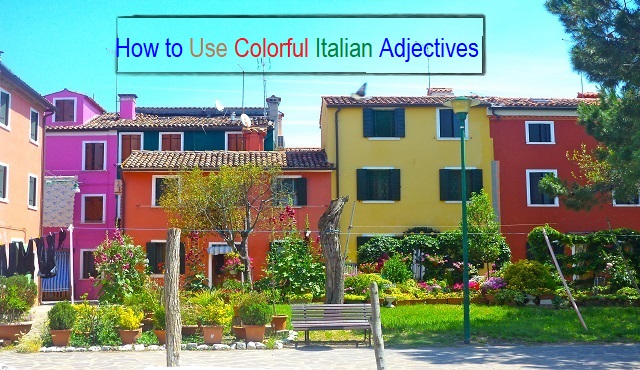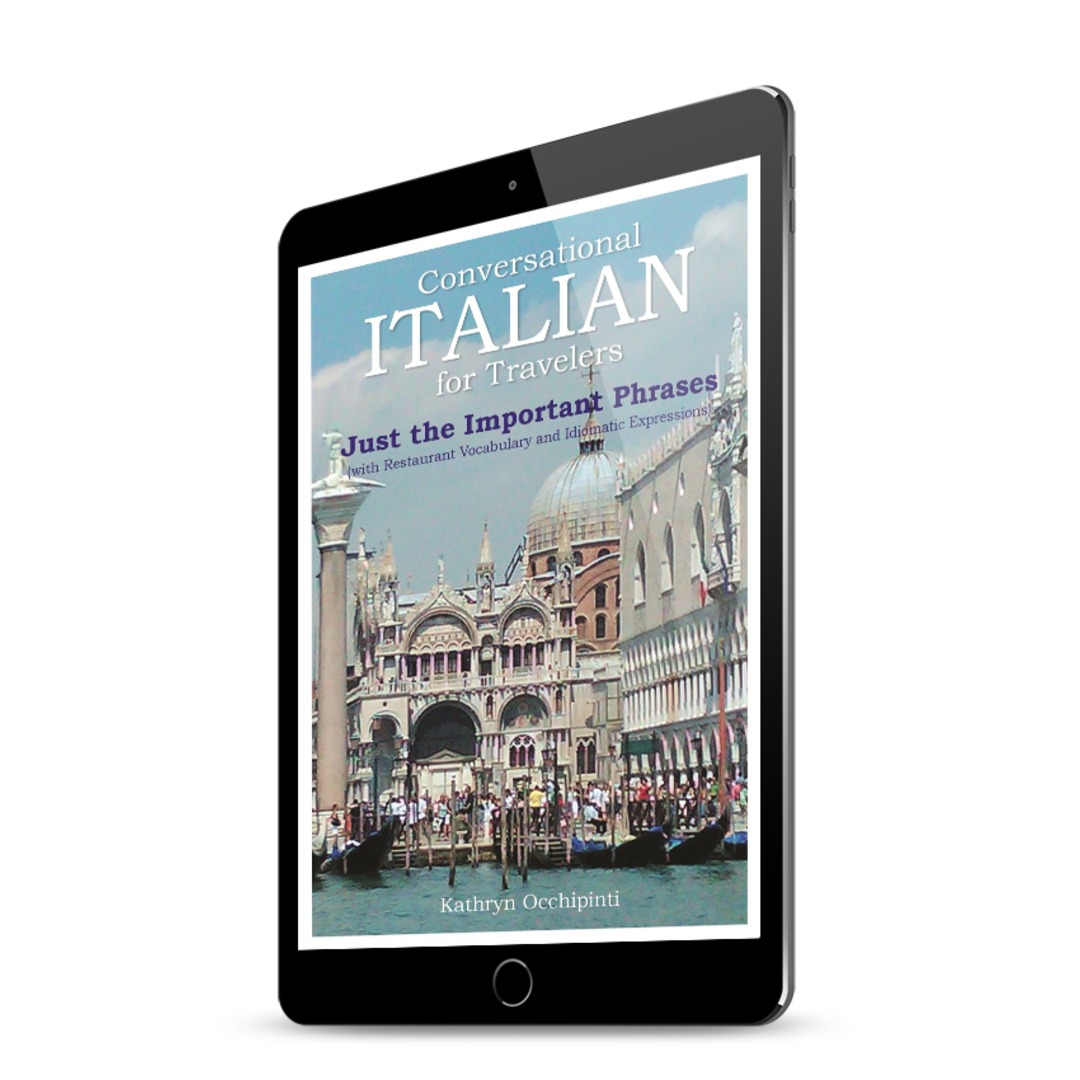
To speak fluently in another language, it is important to know how to describe the characteristics of the people, places, and things that we encounter every day. Adjectives can enliven the listener’s perception of a subject and provide additional shades of meaning.
In English, adjectives are generally placed before the noun. But in Italian, most adjectives are placed after the noun the modify, while a few groups of adjectives are placed before the noun. And finally, many Italian adjectives can hold either position in relation to their noun — either before or after. Interestingly, where an Italian adjective is placed in a sentence can even change its meaning!
Italian Adjectives of Nationality
After the Noun
We discussed how to talk about traveling to a region in Italy or the United States in our last blog in this series, “Getting there with ‘a’ and in” Of course, there are also Italian names for all the countries of the world, as well as for the people who live in each country.
To explain one’s cultural background in Italian, it is necessary to use Italian adjectives of nationality. For men, adjectives of nationality usually end in –o and change to an –i in the plural; for women, these same adjectives end in –a and change to –e in the plural. Therefore, a man from Italy would describe himself as italiano but a woman would say that she is italiana.
Some adjectives of nationality end in –ese, and in this case the same ending is used for both men and women. For the plural of the –ese ending, simply change the last letter –e to an –i.
Below is a sample of nationalities from all four continents. Watch out for the exceptions that are starred! There is no need to memorize the entire list. Instead, look up the nationalities for your family, just in case the topic comes up in conversation!
| European | europeo(a)
(plural: europei, europee) |
African | africano(a) |
| Austrian | austriaco(a) | Asian | asiatico(a) |
| Belgian | belga(a)* | Middle Eastern | mediorientale |
| Danish | danese | ||
| Dutch | olandese | American | americano(a) |
| English | inglese | Central American | centroamericano(a) |
| French | francese | North American | nordamericano(a) |
| German | tedesco(a) | South American | sudamericano(a) |
| Grecian | greco(a)**
(plural greci, greche) |
Australian | australiano(a) |
| Irish | irlandese | ||
| Italian | italiano(a) | Argentinian | argentino(a) |
| Norwegian | norvegese | Brazilian | brasiliano(a) |
| Polish | polacco(a) | Canadian | canadese |
| Portugese | portoghese | Chilean | cileno(a) |
| Scandanavian | scandinavo(a) | Chinese | cinese |
| Spanish | spagnolo(a) | Egyptian | egiziano(a) |
| Swedish | svedese | Indian | indiano(a) |
| Swiss | svizzero(a) | Indonesian | indonesiano(a) |
| Japanese | giapponese | ||
| Korean | coreano(a) | ||
| Mexican | messicano(a) | ||
| Pakistan | pachistano(a) | ||
| Russian | russo(a) | ||
| Turkish | turco(a) | ||
| United States (of America) |
statunitense | ||
| Vietnamese | vietnamita(a)* |
*Exceptions to the rule of masculine and feminine.
**Pronunciation change for the masculine plural and spelling change to keep original sound for the feminine plural.
When speaking about an individual…
Most commonly, short sentences with the verb essere can be used to describe one’s nationality, as we discussed in the blog in this series “How to Use ‘Da’ in Italian.” When someone asks, “Da dove viene?” for “Where are you from?” an Italian would simply say, “Sono italiano(a)” for “I am Italian.” (We have left out the “io” of course, as this is conversational Italian and the subject pronoun is not necessary.)
Italian adjectives of nationality always follow the noun they modify —
that is, persons, places or things from a given country —
and are not capitalized.
To take this one step further, if an Italian wants to describe a friend or relation, they might give the relationship first, and then put the person’s nationality afterward. In this case, the nationality will follow the noun friend, cousin, etc, and provide additional information or possibly emphasize a particular point about that person. Of course, there are many instances when one might want to describe their own or another’s nationality!
Some simple examples are given below, with the nouns and their adjectives underlined and their matching endings highlighted in red. Notice that the English translation puts the adjective of nationality before the noun, as this is the typical sentence structure in English. English adjectives of nationality require capitalization, while Italian adjectives of nationality do not. Also, the English translations may not match word for word given the differences in how Italian and English may express an idea.
Paolo è il mio amico europeo.
Paul is my European friend.
Ti presento Caterina, mia cugina americana.
Let me introduce you to Kathryn, my American cousin.
Anna è una ragazza europea; viene dalla Francia.
Ann is a European girl; she is from France.
Mia mamma è una donna italiana; e quindi lei cucina cibo delizioso ogni sera.
My mother is an Italian woman; and therefore she cooks delicious food every night.
Mio nonno Carmelo è un uomo italiano ma gli piace molto la sua casa in America.
My grandfather Carl is an Italian man but he really likes his house in America.
Italian Adjectives for Colors
After the Noun
Writers and conversationalists alike often use color as a descriptor to enliven the discussion for the listener. Below is a list of adjectives to describe the colors (i colori) in Italian. Some of these adjectives have endings that change to agree with the gender and number of the nouns they describe. In this case, all forms are given. Others are invariable (the endings will not change). Notice the spelling changes for bianchi/bianche, which are made so the endings of the plural adjectives stay true to the “c” sound in the singular.
Adjectives denoting color
always follow the noun they modify.
| bianco/bianca | bianchi/bianche* | white |
| nero/nera | neri/nere | black |
| grigio/grigia | grigi/grigie | gray |
| giallo/gialla | gialli/gialle | yellow |
| rosso/rossa | rossi/rosse | red |
| azzurro/azzurra | azzurri/azzurre | blue |
| verde | verdi | green |
| arancione | orange | |
| marrone | brown | |
| beige | beige | |
| rosa | pink | |
| blu | blue | |
| lilla | lilac/light purple | |
| viola | violet /purple |
Color is used to describe so many places and things… Let’s use our original four examples and add a sentence using one of the colors in Italian to build a story around each character we have created. The nouns and their adjectives with the matching (or invariable) endings are underlined and their endings (or the entire adjective if it is invariable) match the color they refer to. How many more sentences using color can you think of? Create your own short sentences and practice changing the endings of each color when required!
Paolo è il mio amico europeo. A lui piacciono i vestiti neri e di moda.
Paul is my European friend. He favors black clothing that is designer-made.
Ti presento Caterina, mia cugina americana. Lei è venuta a trovarmi in una macchina rossa!
Let me introduce you to Kathryn, my American cousin. She came to visit me in a red car!
Anna è una ragazza europea; viene dalla Francia. Abita in campagna e d’estate dalla sua casa può vedere i fiori gialli, viola, e lilla.
Ann is a European girl; she is from France. She lives in the country, and in the summer from her house she can see yellow, violet, and light purple flowers.
Mia mamma è una donna italiana; e quindi lei cucina cibo delizioso ogni sera. Stasera mangiamo un arrosto e verdure verdi del giardino.
My mother is an Italian woman; and therefore she cooks delicious food every night. Tonight we will eat a roast with green vegetables from the garden.
Mio nonno Carmelo è un uomo italiano ma gli piace molto la sua casa in America. Lui ha dipinto la sua casa blu, come il mare italiano.
My grandfather Carl is an Italian man but he really likes his house in America. He painted his house blue, like the sea around Italy.
Italian Adjectives Before the Noun
Buono, Bello and Personal Characteristics
In the first two sections of this blog, we discussed how adjectives of nationality and color commonly follow the nouns they modify. Most other Italian adjectives will follow the noun as well. Did you notice the phrase “cibo delizioso” in one of our examples from the last section? The adjective delizioso follows the noun cibo in this example!
However, many Italian adjectives are commonly placed before Italian nouns.
Adjectives of size, personality characteristics
(good/bad, young/old, pretty/ugly), and terms of endearment
usually precede the noun.
Buono and bello are adjectives that mean “good” and “beautiful/nice” and can be placed either before or after a noun. These adjectives were discussed in a previous blog. If you need a refresher, visit: Bello means “It’s nice!” and Buono means “It’s good!”
See the table below for a summary of the most important Italian adjectives that commonly precede nouns, with their definitions and their endings for gender and number agreement.
Italian Adjectives that Commonly Precede Nouns
| Definition | Singular Forms | Plural Forms | |
| grande | big, large | grande | grandi |
| piccolo | small | piccolo/piccola | piccoli/piccole |
| stesso | same | stesso/stessa | stessi/stesse |
| buono* | good (behavior) | buon/buono/buona/buon’ | buoni/buone |
| bravo | good (talented) | bravo/brava | bravi/brave |
| cattivo | bad, mean | cattivo/cattiva | cattivi/cattive |
| giovane | young | giovane | giovani |
| anziano | elderly | anziano/anziana | anziani/anziane |
| nuovo | new | nuovo/nuova | nuovi/nuove |
| vecchio | old | vecchio/vecchia | vecchi/vecchie |
| caro | dear/expensive | caro/cara | cari/care |
| vero | true | vero/vera | veri/vere |
| bello* | beautiful, handsome | bel/bello/bella/bell’ | bei/begli/belle |
| brutto | ugly | brutto/brutta | brutti/brutte |
*Remember that the endings for buono and bello when placed after the noun will follow the usual rules for gender and number endings: (singular: o,a) (plural: i,e)!
How can we use this list of adjectives that commonly precede nouns? Well, in some cases placing an adjective before a noun — for instance when describing a person — lends a poetic meaning to the phrase or implies a special feeling for the person. On the other hand, placing that same adjective after the same noun, whether a person or thing, renders a literal meaning.
In the case of vecchio, for instance, “un amico vecchio” is a friend who is old in years, while “un vecchio amico” refers to “an old friend,” or someone who has been one’s friend for a long time.* It is understood that this “old friend” has been a good friend to the speaker and is someone to whom the speaker feels a genuine warmth and attachment.
You will no doubt recognize our old friends buono and bello in this list! In the examples below, notice the change in meaning with a change in the placement of buono and bello as well. And remember that when using the verb essere as a linking verb, the subject and adjective that follows essere must have endings that agree; the subject and its descriptor are one and the same!
un amico vecchio a friend who is old
un vecchio amico a long-time friend
un pilota buono a pilot who is good
un buon pilota a good (skilled) pilot
un uomo cattivo a man who is bad (not helpful/not nice)
un cattivo uomo a mean man
una macchina nuova a (brand) new car
una nuova macchina a different car
Michele è diventato grande. Michael has grown up. (lit. become big)
Pietro è un grande uomo. Peter is a great man.
*To describe a person it is more polite to use anziano (elderly) after the noun, rather than vecchio, since vecchio carries a negative connotation. One who ages well is anziano or anziana!
Let’s take our original 4 example sentences, and add an additional descriptive sentence for each, using one of the adjectives in the list above. In so doing, we will create a short vignette about each character. Notice how the additional information provided by adjectives bring us closer to understanding the person and situation we’ve created.
Once again, the English translations will not correspond “word for word” to the Italian, given that adjective placement and description is often different for each language. Use these lines as a starting point and create a longer story about each character (in Italian) if you want!
Paolo è il mio vecchio amico europeo. A lui piacciono i vestiti neri e di moda. Lui è un buon pilota e viaggia intorno al mondo.
Paul is my long-time European friend. He favors black clothing that is designer-made. He is a skilled pilot and travels all around the world.
Ti presento Caterina, mia cugina americana. Lei è venuta a trovarmi in una macchina rossa nuova!
Il suo papà ha comprato la macchina per lei perché è una brava studentessa.
Let me introduce you to Kathryn, my American cousin. She came to visit me in a brand-new red car!
Her father bought the car for her because she is a talented student (does very well at school).
Anna è una ragazza europea; viene dalla Francia. Abita in campagna e d’estate dalla sua casa può vedere i fiori gialli, viola, e lilla. Anna è diventata grande in campagna e spera di sposarsi e fare crescere i figli là.
Ann is a European girl; she is from France. She lives in the country, and in the summer from her house she can see yellow, violet, and light purple flowers. She has grown up in the country and hopes to marry and raise children there.
Mia mamma è una donna italiana; e quindi lei cucina cibo delizioso ogni sera. Stasera mangiamo un arrosto e verdure verdi del giardino. La sua amica anziana ha ottanta anni e viene a cena con noi ogni tanto.
My mother is an Italian woman; and therefore she cooks delicious food every night. Tonight we will eat a roast with green vegetables from the garden. Her 80 year-old elderly friend comes to dinner with us every now and then.
Mio nonno Carmelo è un uomo italiano ma gli piace molto la sua casa in America. Lui ha dipinto la sua casa blu, come il mare italiano. Secondo me, lui è un grand’ uomo.
My grandfather Carl is an Italian man but he really likes his house in America. He painted his house blue, like the sea around Italy. According to me, he is a great man.
Remember how to use
Colorful Italian Adjectives
and I guarantee you will sound like a native Italian every day!
For “All the Italian you need to enjoy your trip to Italy” click on the links for my Conversational Italian for Travelers books -Kathryn Occhipinti


 Fra Noi Embrace Your Inner Italian
Fra Noi Embrace Your Inner Italian







One comment
Pingback: Possessive adjectives for things – Fra Noi